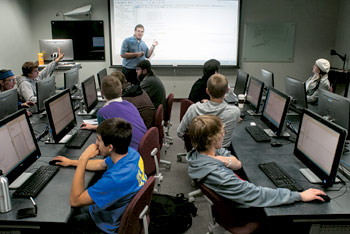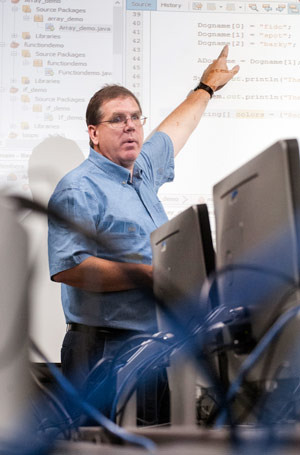The traditional avatar of a child prodigy was manifested in the musical mastery of Mozart or Beethoven, who began composing at the age of 5, or the early artistic flair of Picasso.
That paradigm is shifting, and the new prototype – the wunderkind of the future – is beginning to look very different.
It’s the kindergarten computing virtuoso. The pre-adolescent programmer. The software sophist.
It’s Steve Jobs, Bill Gates and Mark Zuckerberg.
In Montana and the Flathead Valley, where skilled labor has traditionally been applied to timber mills, mines and machinery, tech mavens are a rarefied commodity – despite an economy increasingly characterized by a glut of jobs requiring technological skills and a dearth of qualified workers.
The marketplace doesn’t have to continue trending that way. And according to teachers, school administrators, business and community leaders, and a burgeoning generation of young people with an interest in and an aptitude for technological innovation, it won’t for long.
Soon, Montana’s workforce will be mining for 1’s and 0’s.
Binary code is the new lingua franca, and the academic world is slowly beginning to recognize it. In the near future, C++ won’t be a mark of mediocrity on a report card, but a programming language built into a school’s core curriculum.
Right now, that curriculum isn’t mainstream, but school officials hope to bring it off the fringe soon.
“We definitely want to get on board, and get on board pretty quickly,” Whitefish High School Principal Kerry Drown said. “This is exactly what we have been waiting for to help our students access these career opportunities.”
Whitefish City Councilor John Anderson, an attorney who works with tech companies, recognizes the importance of exposing Montana youth to computer programming skills early on. A parent of two boys who both have a talent for math and science, he wants to afford them the opportunity to enter a workforce that’s rife with opportunity in the Flathead Valley.
“The workforce is changing. It’s becoming more technical and the better equipped you are the more success you will have in achieving professional goals,” he said. “So the model of education has to change. This is coming and if the kids aren’t ready for it, I think we will be doing a tremendous disservice to them.”
At Whitefish High School, which is undergoing a transformative building project that will help facilitate a more robust technology program, school administrators and technology instructors are talking to Anderson about developing a fuller curriculum that includes computer engineering and more advanced coding language.
Adopting such a program will take time.
“They want to get into binary coding, but right now there is no tech curriculum that you can buy off the shelf like there is an English curriculum or a math curriculum,” Anderson said. “That needs to be developed. It’s not something that is going to happen over night, but Whitefish is in a unique position to adopt that curriculum.”
The demand for high-paying computer-related jobs in Montana far outstrips the number of computer-science graduates, exceeding a growing ratio of 10:1. Nationally, the demand for software developers already outweighs supply, and it’s expected to increase by 30 percent by 2020 – more than double the average for all other jobs.
 |
|
Instructor Jim Goudy talks to his computer programming class about Java coding. – Greg Lindstrom | Flathead Beacon |
Montana State University, the University of Montana and Montana Tech only produce about 11 percent of the computer science graduates that Montana’s high-tech businesses would hire if more were available. And the starting salaries range from $45,000 to $85,000, making them some of the best paying jobs in the state.
The result, observers say, is an underperforming economy and a statewide exodus of young, job-seeking graduates.
The starkness of that picture was the impetus behind Greg Gianforte’s CodeMontana, a program that targets teenagers and encourages an incipient interest in computer science.
“Last spring, Montana State University graduated 19 computer science graduates. U of M graduated 18. Montana Tech graduated nine – for a statewide total of 44. That’s 44 jobs for 400 openings,” he said.
Gianforte, the founder of RightNow Technologies, a software company headquartered in Bozeman that in 2011 was absorbed by Oracle Corporation, launched CodeMontana publicly last month at the Montana Economic Development Summit in Butte, where for two days technology was an emergent theme.
“We had 100 applicants for every job and an average salary of $86,000. But the reality was, of those 100 applicants we got for every job, 99 were under-qualified or unqualified,” Gianforte said of RightNow, which has grown to more than 1,000 employees.
“I thought, ‘how could we do a better job?’ We’re 48th in the country for wage scale. I have been working for 20 years to create good-paying jobs in the state and we’ve got them now. But we don’t have the people. It’s kind of ironic. Our vision with CodeMontana is to give every Montana high school student exposure to computer science,” he said.
In the Flathead Valley, tech and software businesses like NxGen, Vubiquity, NFS, Torrent, ZaneRay, Dillon Software, American Web and Applied Materials face a similar predicament as they troll for local talent to fill positions in the region’s rapidly growing tech market.
“Every student who graduates from my web-technology program graduates with a job. Usually they’re hired before they graduate,” said Dawn Rauscher, the web technology instructor at Flathead Valley Community College. “I run out of people to give jobs to.”
One of Rauscher’s students, Amy Stewart, a 2011 graduate, went back to school at the age of 38. Tired of trying to eke out a living as a painter, she gave computer programming a shot and displayed an instant talent.
Immediately upon graduating, she was hired at Vubiquity, landing a high-paying job at one of the nation’s fastest-growing tech companies, with an office in Kalispell.
Since then, she’s been working to encourage interest in computer technology among young people. She recently became a volunteer mentor with CodeMontana, and has even taught programming to her boyfriend’s 9-year-old daughter. She likens it to teaching a child a foreign language or a musical instrument, which their young minds rapidly absorb.
“They just have more space to learn new skills,” she said.
 |
|
Instructor Jim Goudy talks to his computer programming class about Java coding. – Greg Lindstrom | Flathead Beacon |
She also works with Expanding Your Horizons, a Flathead Valley group that organizes programs to encourage young women to pursue degrees in science, technology, engineering and mathematics. She said seventh- and eighth-grade girls traveled from as far away as Cut Bank to attend her courses on computer programming language.
“This has become my latest developing passion,” she said. “We’re just prime eligible candidates here waiting for people to move in with their great businesses, and having skilled young people is critical.”
Nick Thiel was involved early on in helping establish the Montana Programmers Association’s meet-up group, which was launched by two people in Polson and has since grown to more than 750 members.
“It happened pretty organically because, as it turned out, there were a lot of people with common, tech-y interests who were eager to get together,” he said.
As a former computer science instructor at FVCC, Thiel noticed a lack of aptitude among students who were unfamiliar with and didn’t possess the patience for problem solving, a key component of computer programming, information technology, web development and human innovation.
“Culturally, we face a fundamental challenge. We have the capacity and the technology to avoid a lot of pain and discomfort, so we end up bypassing a lot of challenges in life by leaning on technology as consumers,” he said. “By short circuiting our problems, we avoid dealing with them directly, sometimes until we’re 25 or 30. I think challenging students at an early age so that they face challenges that aren’t easily overcome is key.”
Computer science is a valuable primary skill, he said, but also a useful complement to all manner of skillsets – the English major who can write code and content; the economist who can design a company’s website and understand its bottom line.
Computer science-based knowledge sets job candidates apart from their competition.
“If you add the skill to your primary interest or passion, it differentiates you from almost everyone else in your field,” he said.
It also eliminates geographical constraints, allowing workers to stay in Montana, while leaving a small footprint on the community.
Thiel said he regularly meets people in the Flathead Valley who work in the technology field, often making upwards of six figures computing out of their living room.
“GIS, Twitter, designing websites, whatever, whoever, they’re working out of their house and making good money,” he said.
Rob Irizarry, who previously worked at Oracle, is an organizer with the Montana Programmers Association and helped launch CodeMontana, says the self-paced, online training program already has nearly 300 high school students.
The goal is 1,000, and Irizarry encourages his own children – ages 7, 11 and 16 – to hone their skills as programmers.
“I don’t want them to have to leave Montana,” he said. “And computer technology is a clean industry. It creates jobs and it helps keep this place special.”
Anderson, the Whitefish city councilor and attorney who cut his teeth lawyering for the tech industry in Austin, Texas, said for every computer programming job added in Montana, there is a multiplying effect.
“There is a bountiful, cascading effect of having technology creators and code writers,” he said. “You need someone to write marketing materials, someone with management experience, someone with a law degree. All things flow from the tech-creation effort.”
It all begins with education at a young age and pioneering teachers building a foundation, he said, as well as by demystifying the notion that modern youth are already technologically savvy simply because they own tablets and smartphones.
“Our kids are great consumers of technology. We want to teach our kids to create technology,” he said.
“For a community to be successful you have to have a vision, you have to be able to see what is coming down the pike and you have to hope your community is willing to embrace it. And in Whitefish and the Flathead Valley, there is no doubt about it,” he said.
At FVCC, a dozen students sit in front of their CPUs, typing bracketed commands in an arrayed matrix of rows and columns, ones and zeroes. This is professor James Goudy’s computer science class, and he’s teaching a popular programming language called Java.
As the students explain the catalyst to study computer science and web technology, a familiar theme emerges – in a world saturated with technology, there comes a desire to understand how it works – instead of technology telling them what to do, rather than be at its mercy, they want it to work for them.
“It’s like learning a new language. You can’t just learn what words are in the language. You have to learn the grammar in order to make sense,” said Skyler Bexten, who graduated from Glacier High School this summer.
“It’s a lot of information but just in the short time I’ve been in the class I’ve been able to retain a lot of it,” Glen Marsh, also a 2013 Glacier grad, said.
Gianforte, the founder of RightNow, said he hopes students will continue to fill out and expand Montana’s computer science programs, and that, due in part to CodeMontana, they arrive in class better prepared.
“Code is kind of a geeky thing,” he said. “But these days, being a geek is cool.”